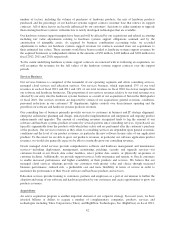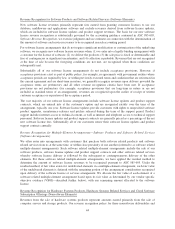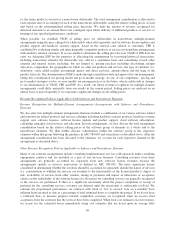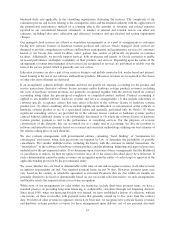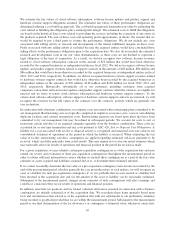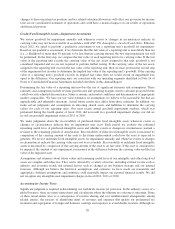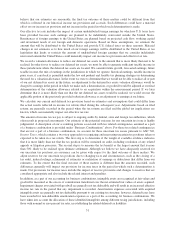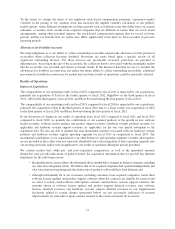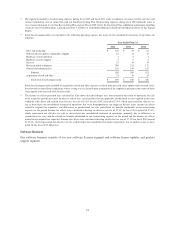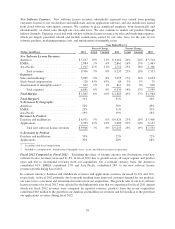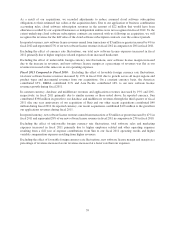Oracle 2012 Annual Report Download - page 55
Download and view the complete annual report
Please find page 55 of the 2012 Oracle annual report below. You can navigate through the pages in the report by either clicking on the pages listed below, or by using the keyword search tool below to find specific information within the annual report.believe that our estimates are reasonable, the final tax outcome of these matters could be different from that
which is reflected in our historical income tax provisions and accruals. Such differences could have a material
effect on our income tax provision and net income in the period in which such determination is made.
Our effective tax rate includes the impact of certain undistributed foreign earnings for which no U.S. taxes have
been provided because such earnings are planned to be indefinitely reinvested outside the United States.
Remittances of foreign earnings to the United States are planned based on projected cash flow, working capital
and investment needs of our foreign and domestic operations. Based on these assumptions, we estimate the
amount that will be distributed to the United States and provide U.S. federal taxes on these amounts. Material
changes in our estimates as to how much of our foreign earnings will be distributed to the United States or tax
legislation that limits or restricts the amount of undistributed foreign earnings that we consider indefinitely
reinvested outside the United States could materially impact our income tax provision and effective tax rate.
We record a valuation allowance to reduce our deferred tax assets to the amount that is more likely than not to be
realized. In order for us to realize our deferred tax assets, we must be able to generate sufficient taxable income in
those jurisdictions where the deferred tax assets are located. We consider future growth, forecasted earnings, future
taxable income, the mix of earnings in the jurisdictions in which we operate, historical earnings, taxable income in
prior years, if carryback is permitted under the law and prudent and feasible tax planning strategies in determining
the need for a valuation allowance. In the event we were to determine that we would not be able to realize all or part
of our net deferred tax assets in the future, an adjustment to the deferred tax assets valuation allowance would be
charged to earnings in the period in which we make such a determination, or goodwill would be adjusted at our final
determination of the valuation allowance related to an acquisition within the measurement period. If we later
determine that it is more likely than not that the net deferred tax assets would be realized, we would reverse the
applicable portion of the previously provided valuation allowance as an adjustment to earnings at such time.
We calculate our current and deferred tax provision based on estimates and assumptions that could differ from
the actual results reflected in income tax returns filed during the subsequent year. Adjustments based on filed
returns are generally recorded in the period when the tax returns are filed and the global tax implications are
known, which can materially impact our effective tax rate.
The amount of income tax we pay is subject to ongoing audits by federal, state and foreign tax authorities, which
often result in proposed assessments. Our estimate of the potential outcome for any uncertain tax issue is highly
judgmental. A description of our accounting policies associated with tax related contingencies assumed as a part
of a business combination is provided under “Business Combinations” above. For those tax related contingencies
that are not a part of a business combination, we account for these uncertain tax issues pursuant to ASC 740,
Income Taxes, which contains a two-step approach to recognizing and measuring uncertain tax positions taken or
expected to be taken in a tax return. The first step is to determine if the weight of available evidence indicates
that it is more likely than not that the tax position will be sustained on audit, including resolution of any related
appeals or litigation processes. The second step is to measure the tax benefit as the largest amount that is more
than 50% likely to be realized upon ultimate settlement. Although we believe we have adequately reserved for
our uncertain tax positions, no assurance can be given with respect to the final outcome of these matters. We
adjust reserves for our uncertain tax positions due to changing facts and circumstances, such as the closing of a
tax audit, judicial rulings, refinement of estimates or realization of earnings or deductions that differ from our
estimates. To the extent that the final outcome of these matters is different than the amounts recorded, such
differences generally will impact our provision for income taxes in the period in which such a determination is
made. Our provisions for income taxes include the impact of reserve provisions and changes to reserves that are
considered appropriate and also include the related interest and penalties.
In addition, as a part of our accounting for business combinations, intangible assets are recognized at fair values and
goodwill is measured as the excess of consideration transferred over the net estimated fair values of assets acquired.
Impairment charges associated with goodwill are generally not tax deductible and will result in an increased effective
income tax rate in the period that any impairment is recorded. Amortization expenses associated with acquired
intangible assets are generally not tax deductible pursuant to our existing tax structure; however, deferred taxes have
been recorded for non-deductible amortization expenses as a part of the accounting for business combinations. We
have taken into account the allocation of these identified intangibles among different taxing jurisdictions, including
those with nominal or zero percent tax rates, in establishing the related deferred tax liabilities.
51



